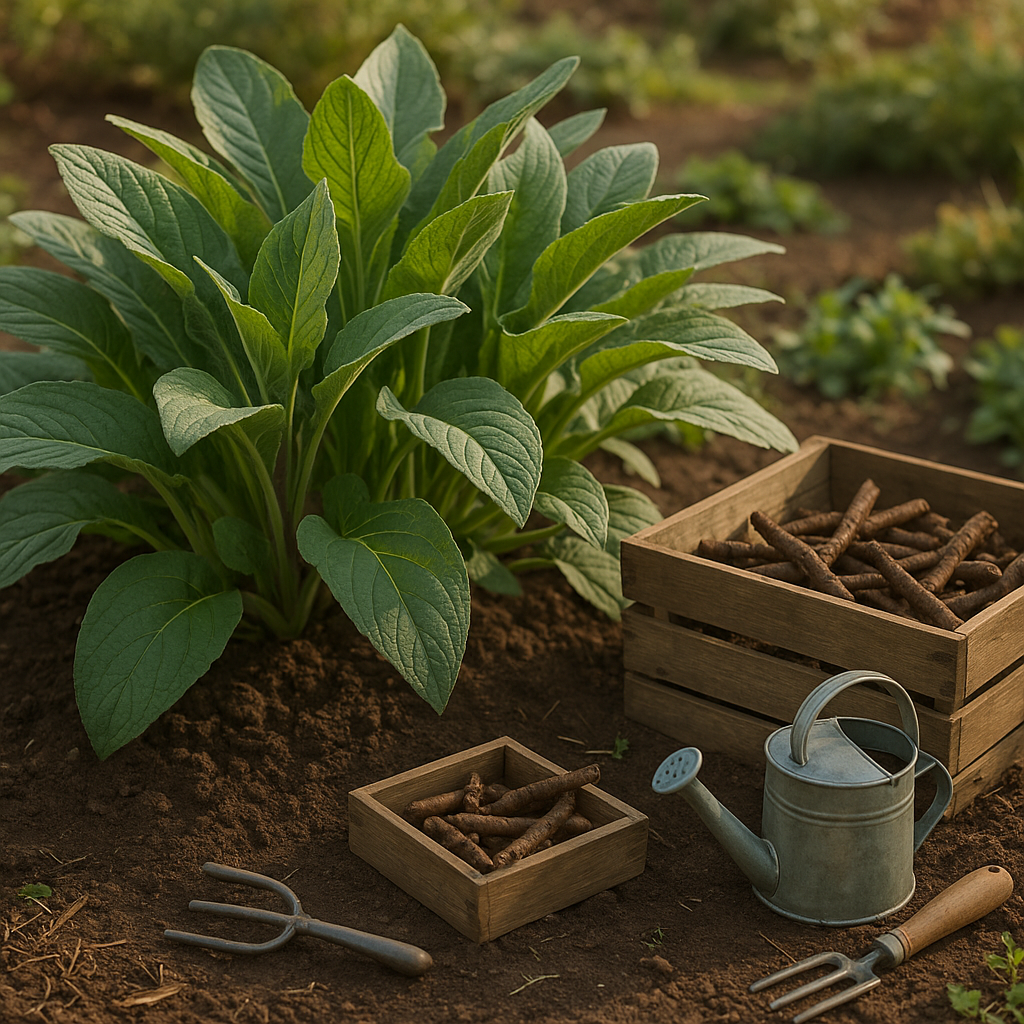Introduction
Comfrey is a beloved plant in many home gardens, prized for its impressive medicinal uses, nutrient-rich compost, and as a superb living mulch. If you want to get started, learning how to grow comfrey from root is one of the easiest and most reliable methods. In this guide, we’ll walk you through step-by-step how to grow comfrey from roots or crowns, so you can quickly establish your own patch. Whether you’re a beginner just starting your gardening journey or an experienced green thumb, you’ll find practical tips to help your comfrey thrive right from the start.
Choosing the Right Comfrey Variety

When picking comfrey for your garden, it’s important to understand the difference between common comfrey (Symphytum officinale) and Russian comfrey, especially the popular Bocking 14 strain. Common comfrey produces seeds readily and can spread invasively, making it harder to control. In contrast, Bocking 14 is a sterile hybrid, so it only spreads through its roots and won’t take over your garden with unwanted seedlings.
Bocking 14 is especially prized for its rapid growth and higher levels of useful nutrients, making it ideal for compost, mulch, or animal fodder. If you want to avoid extra weeding and keep your comfrey patch contained, sterile varieties like Bocking 14 are your best bet.
When sourcing plants, choose healthy roots or crowns from a reputable nursery or trusted gardener—look for plump, undamaged pieces with visible buds. Avoid buying dried or shriveled roots, as they may fail to establish well.
Preparing to Plant
Getting your garden ready for comfrey starts with the soil—aim for a spot with rich, moist, and well-drained earth. Comfrey thrives in loamy soil enriched with compost or aged manure, so be sure to mix in organic matter to boost fertility before planting.
For location, full sun is best for robust growth, but comfrey can tolerate partial shade if needed. Give each plant plenty of room—about three feet apart—as mature comfrey grows large and spreads.
When it comes to timing, plant dormant comfrey roots or crowns either in early spring, as the soil warms up, or in the fall, a few weeks before the first hard frost. Early spring planting helps the roots establish before the hot weather hits, while fall planting allows the roots to settle in over winter.
Taking the time to prepare the right soil and pick the perfect spot will set your comfrey up for years of healthy growth.
How to Plant Comfrey from Roots

Planting comfrey from root cuttings is simple and rewarding. Start by choosing a well-drained, sunny spot in your garden. Dig a hole about 2–3 inches deep for each cutting, and place the root horizontally, making sure it’s covered with soil.
Space each cutting 18–24 inches apart to give the comfrey room to grow—it’s a vigorous plant and needs space. Gently firm the soil over the roots and water thoroughly right after planting.
For the first two to three weeks, keep the soil consistently moist but not waterlogged; comfrey roots establish much faster with regular watering, especially in dry weather. If you notice new green shoots poking through the soil within the first month, this is a good sign your comfrey is taking root.
Healthy roots may also send up several small shoots, so don’t worry if growth seems slow at first. Patience pays off: some cuttings take a little longer but will catch up quickly.
If a root cutting hasn’t shown any new green after four weeks but still seems firm when you gently probe the soil, give it more time. Avoid fertilizing at this stage; just consistent watering and patience will help your comfrey settle in beautifully.
How to Plant Comfrey Crowns
When planting comfrey, it’s important to know the difference between crowns and root cuttings. Crowns are pieces of the mature plant that include established shoots and sometimes small leaves, while root cuttings are simply sections of root with no above-ground growth yet. If you want quick results, crowns are the way to go.
To plant comfrey crowns, start by picking a sunny spot with well-drained soil. Dig a hole deep enough to cover the crown by about two inches, making sure any shoots are just peeking above the surface. Place the crown in the hole, backfill with soil, and water thoroughly.
Space each crown about two feet apart to allow room for leafy growth. Crowns often establish faster and stronger than root cuttings, as their shoots quickly send up new leaves—sometimes in just a couple of weeks—giving your comfrey patch a head start on the growing season.
Caring for Your Comfrey Plants
When caring for comfrey plants, start by providing regular, deep watering for young seedlings—especially during dry spells—to help their roots establish well. Applying a thick mulch of straw or leaf mold early on helps retain moisture and suppress weeds.
After planting, lightly feed your comfrey with compost or a balanced organic fertilizer to give it a healthy boost. As the season progresses, keep an eye out for weeds, since comfrey grows best without competition. Remove any intruders by hand to keep your plants thriving.
After three to four years, if your comfrey patch looks crowded, dig up and divide the clumps in spring or fall to maintain plant vigor. Watch for root rot, which can occur if the soil is poorly drained—consider raising beds or amending clay soil with compost to give roots more breathing room.
Pests are rarely an issue, but slugs may target young leaves. Use natural barriers or pellets as needed to protect your plants. With regular care, comfrey will reliably produce lush, leafy growth year after year.
Harvesting and Using Comfrey
Wait until your comfrey plant is well-established, usually at least one full growing season (about a year), before making your first harvest. After that, the best time to cut comfrey leaves is in late spring or early summer, before flowering, when nutrients are most concentrated.
Use sharp shears to cut stems about two inches above the ground. You can repeat this process up to four times per season.
Comfrey leaves are excellent as a nutrient-packed liquid fertilizer—simply steep chopped leaves in water for a few weeks. You can also use them as mulch or add them to your compost pile as a rich activator.
